Your Cart is Empty
Menu
-
- Shop by Type
- End of Line Sale Items
- New In
- Viking Gifts Under $30
- Hand Forged Axes
- Silver Viking Jewelry
- Stainless Steel Jewelry
- Cremation Jewelry
- Necklaces and Pendants
- Hand Carved Wooden Pendants
- Kings Chains
- Viking Drinking Horns
- Pendant Chains
- Rings
- Bracelets
- Earrings
- Beard Beads and Beard Rings
- Collectables
- Ceramic Mugs
- Street Wear
- Horn Jewelry
- Bronze and Pewter Jewelry
- Shop by Theme
- Viking Axe
- Celtic Jewelry
- Dragon or Serpent
- Viking Raven
- Wolf / Fenrir
- Rune Jewelry
- Odin Jewelry
- Ram / Goat
- Shieldmaidens / Lagertha
- Sword, Spear or Arrow
- Thor's Hammer / Mjolnir
- Tree of Life / Yggdrasil
- Helm of Awe / Aegishjalmur
- Triquetra or Triskelion
- Valknut / Knot of Slain
- Vegvisir / Viking Compass
- Veles / Bear
- Blogs
- Help
-
- Login

Thor

Thor is the husband of Sif and the god of thunder in Germanic and Norse mythology. In etymology and function, Thor is virtually identical to the ancient Indian god Indra, and in function and to some extent to both the Greek god Zeus and the Roman Jupiter.
The name Thor is also related to the words thunder and storm - like the English thunder and German Donner. In most Germanic languages, Thor has given its name to Thursday.
In the myths written down in Iceland in the Middle Ages, Thor was Odin's eldest son, and the second most powerful god in the Aesir lineage, after Odin himself.
As the god of thunder, he ruled the weather, fought the enemies of civilisation such as giants and goblins, and protected the land of gods and men from creatures of chaos such as the Midgard Serpent.
He was also called Asathor, was the son of Jord the Earth Goddess and married to Sif. With her he had two children, Trud and Modi. With the giantess Jernsaxa he had the boy Magni.
Although he was often warlike in his appearance, he rarely functioned as a war god, the Aesir's main war gods were Tyr and Odin.
Thor was invoked in matters concerning wind, weather and growth, for he controlled the forces of nature which could damage crops. Behind his brutal appearance, Thor stood for law and order and the maintenance of peace in society.
Thor, Odin and Loki are the three figures who appear most often in mythological tales, while other sources indicate that Thor, along with Odin and Freyr, were the most important gods to the Germanic peoples.
Background
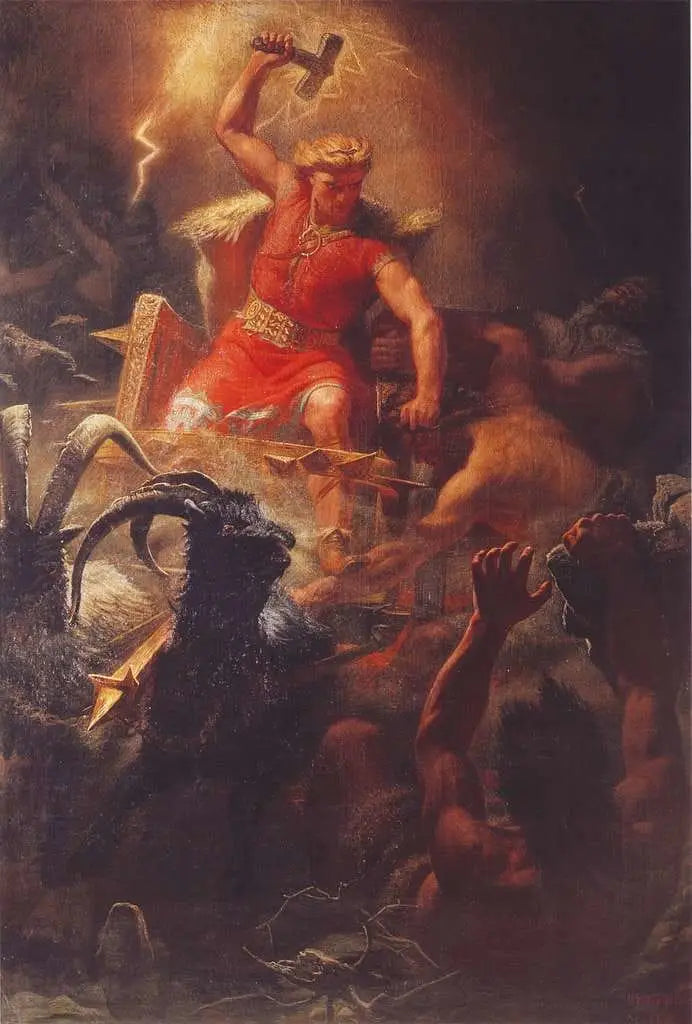
Thor was worshipped throughout Europe in the Iron Age. Various sources indicate that groves or individual trees served as sanctuaries for Thor worshippers, missionaries in northern Europe in the 8th century readily counted the felling of sacred groves among their greatest achievements.
Around 1000, a forest dedicated to Thor still existed near Dublin in Ireland, and place names in both Scandinavia and England bear witness to sacred forests, e.g. Thorslund in Denmark and Thundersley in Essex.
In Iceland, where there were no actual forests, this connection lost its significance. However, it may have survived in the form of sacred mounds brought from the motherland by the first settlers.
The cult of Thor lived long in northern and western Europe; from the 1st century we have vague descriptions of southern Germanic soldiers in Roman service invoking Hercules, a Latinisation of Thor, and from the north there is evidence of continuous worship of the god well into modern times, Christian saints even taking over Thor's role in tales of troll-killing and the like.
In the transitional period, when Christianity was gaining ground, Thor was seen as the main antithesis of Christ; and there is much evidence to suggest that he was seen as the most important deity in Germanic and Norse religion.
In several Christian tales, Thor plays a crucial role as an idol or demon, and even men who were actually Christians could, in some stories, invoke Thor when they were in dire need.
In folklore, the notion of trees and wooden pillars as protection against lightning and storms survived long after the change of religion; for example, the erection of a symbolic tree at travel festivals may be a relic of an ancient ritual associated with Thor.
In an account of St Bonafacius' mission to northern Europe, he is said to have cut down a significant oak tree, called the Oak of Donar, around 723 near Geismar to demonstrate the powerlessness of the pagan gods in the face of the Christian god.
This event marked Germany's conversion to Christianity. This shrine was an important cult centre for the Germanic tribe of Chatti, who inhabited present-day Hesse. Thor, in the form Thonar, is also mentioned in an old Saxon baptismal vow from the 8th or 9th century.
Personality and Function
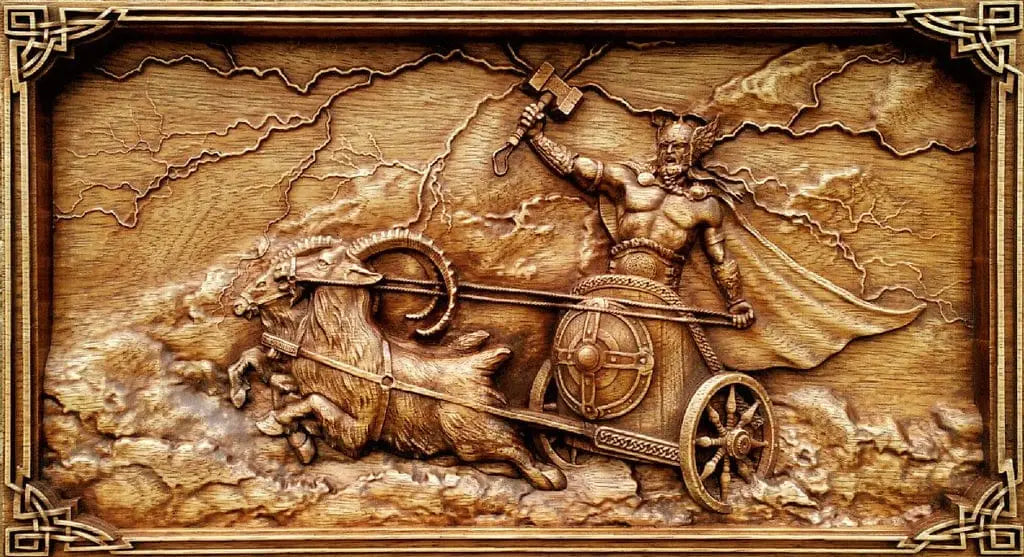
Thor was married to Sif. Her name means 'kinship through marriage'. Together with Sif he had the son Mode and the daughter Trud (Courage and Strength).
Thor also had children with a number of other women, including the son Magni (Strength) with the giantess Jernsaxa. As the names suggest, his children were personifications of his main mythological role.
Thor's stronghold in Asgard was called Bilskirner and was located in Trudvang, it was Thor's kingdom, and the name means the dwelling of the Strong. Thor's servants were called Tjalfe and Roskva; they were human.
Thor got the two siblings from the farmer as compensation after one of Thor's rams had become injured after a careless accident during an evening meal at their home.
Thor is described in many places as having a red beard, this, like his sparkling eyes and powerful voice, was probably a reference to thunderstorms or even the reddish sky before a storm, and was linked to his role as weather god.
According to Snorre Sturluson, the otherwise almost unknown god Ullr was Thor's stepson, and thus Sif's son from a previous relationship. He is a very faded figure in the written sources, and there is no trace of his worship in either Denmark or Iceland.
The few relics that exist to representations of him show that he was an ancient god of heaven and justice, associated with ritual rings of gold; elements that in Icelandic sources were also strongly associated with Thor.
In the late pagan period, Ullr appeared mainly in connection with hunting, skiing and mountains. Thor's mother was Fjorgynn, but other than that she appears as little more than a name in the sources.
Ullr was perhaps not the only god Thor came to overshadow, along with Odin, Thor apparently took over many of the attributes and functions previously held by the old sky god Tiwaz, this shift left Tyr a somewhat faded figure in Norse mythology. In the sources, Thor therefore appears as the god of society as a whole.
Comparisons between the many different sources Thor appeared in show that his overall function was to be the protector of gods and men against destructive forces of nature; he ensured that the constant threat to the cosmos was not realised.
The vast majority of sources that tell of battles between giants and gods have Thor as either the main character or an important supporting figure. Several myths featuring Thor also include battles with monsters. The battles against them were, in reality, merely a particularly significant expression of his capacity as guardian of the cosmos.
The giants were not unequivocally evil, but were a counter-power to the gods, representing chaos in the face of the order of the gods. In some cases he had a more peaceful relationship with the giants.
Compared to Odin, the brooder and schemer, Thor's psyche was simple and straightforward, his most important attribute being his masculine strength, which he used to solve problems.
Perceptiveness and cunning were also used, though more rarely, one such case being Alvíssmál, where he tricks the dwarf Alvis into answering his questions until the sun rises and Alvis turns to stone. But usually Thor's method was the use of his formidable strength to defeat his enemies.
Overall, the difference between him and Odin lay more in society's social differences than in anything religious. Their main functions were basically the same, namely to maintain world order, but where Thor was the god of the whole society, Odin was the god of only certain social classes.
In Hárbradsljód, Thor's killing of the giants is presented as a kind of population control, which the Aesir considered necessary for fear that the numbers of the giants would grow so large that they would threaten the Aesir's position of power.
But combined with his temperament, Thor's simple nature could cause the world order to be put at risk, as happened when he tried to capture the Midgard Serpent.
Like many of the Aesir, he was invoked in many different situations, for example, he acted as both fertility god and justice god, as a helper when one was in need, weather god, and on rare occasions he was also invoked in war, but usually always on the basis of his role as protector against harmful forces.
Thor has often been categorised as a war god, although the source material does not support this. Nowhere does he appear as a strategist, but acts primarily impulsively and short-sightedly, something that is even made fun of in myths from the Viking Age.
His manner was far removed from the warrior ideal of the time. In the myths, his warlike behaviour is purely a consequence of his role as protector and guardian of the cosmos.
Thor had power over the weather. He provided rain and wind, and when he drove across the sky, lightning would leap from his chariot and thunder on the earth. That is why he was also an important god for seafarers and fertility.
Thor's most important attribute was the hammer Mjolnir, which together with the belt of strength Megingjord and a pair of iron gloves Iarngreiper made him incredibly strong. Mjolnir was the greatest treasure of the gods, as it enabled Thor to protect Asgard from the giants.
Thor also had a chariot pulled by two rams, Tanngnjost and Tanngrisner (meaning the gnashing of teeth and the space between the teeth).
The goats he could eat, as long as he collected their bones in their skins afterwards, he could make them alive the next day. When the giants heard that he was running out, they were terrified and hid, because it was usually to fight with them that he did it.
His special attachment to the land is seen in Snorre Sturluson's tale Gylfaginning, where it is said that Thor, unlike the other gods, preferred to walk over land and through rivers rather than ride on horseback when he went to the gods' Thing Assembly at the foot of Yggdrasil.
Many Viking Age jewelry depicts his hammer Mjolnir, a sign of Thor's great popularity during this period. He was apparently even deliberately used by followers of the old religion as a pagan counterpoint to Christ during the change of religion.
Like the other gods, he was not immortal, and in the doomsday battle of Ragnarok he will battle the Midgard Serpent, they will kill each other, both his sons, however, will survive the downfall of the old world and continue his role in the new.
Especially when Christianity becomes a serious competitor to the old religion, Thor's hammer became a symbol for the followers of the traditional religion, in the same way as the cross was for the Christians, and Thor was, for example, seen in Norway as a direct opponent of Olav Tryggvason.
Sources
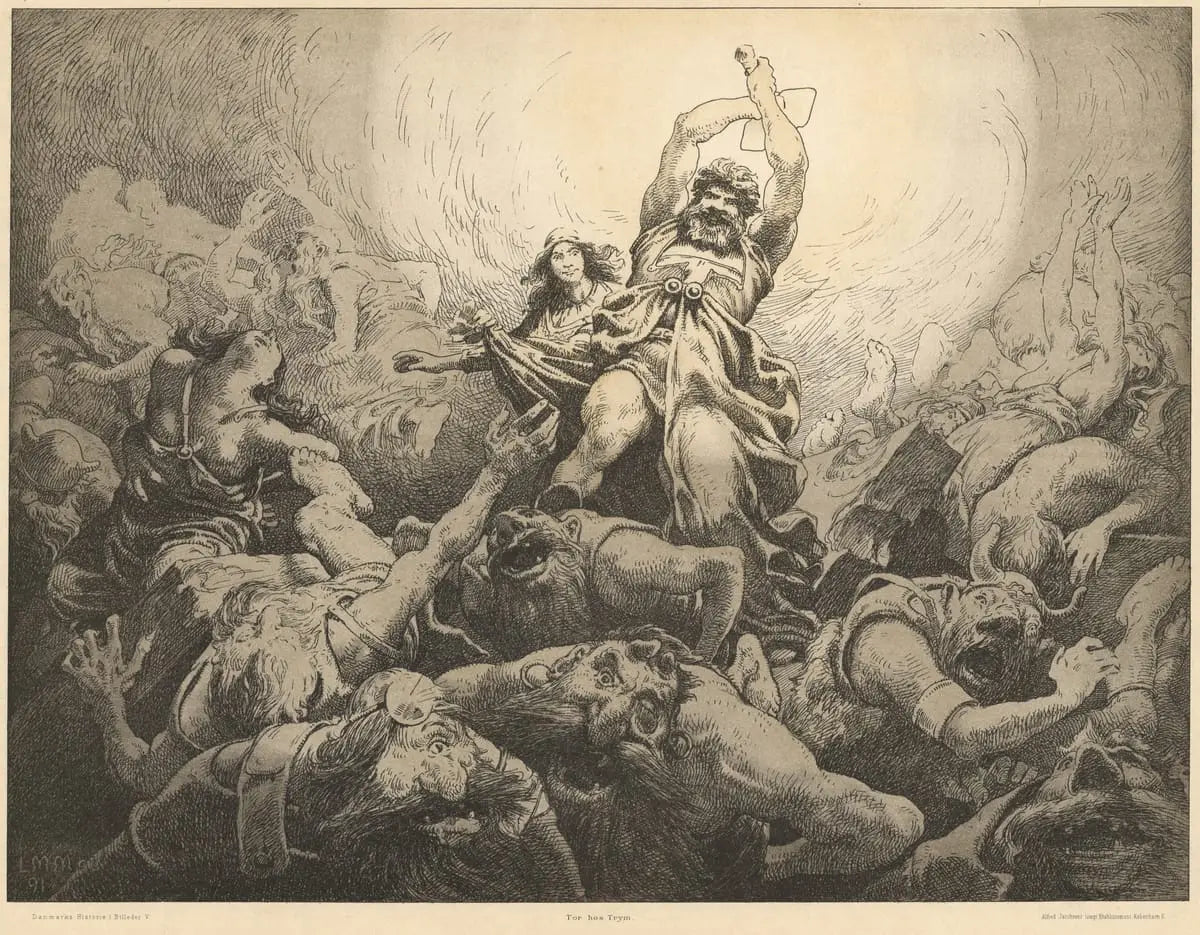
The two collections of texts that contain the greatest amount of information about Thor are the Icelandic writings Old and Younger Edda. The former is a collection of religious poems of pre-Christian oral origin, which were collected and written down in the 13th century.
The second is an edited retelling of older pagan myths, some of which are preserved in the Old Edda; this text was written by Snorri Sturluson, and is also from the 13th century.
It depicts Thor and the other Aesir as part god and part man, who deceived the Norse into believing that the Aesir were gods. Nevertheless, Snorre retells a number of myths in which both Thor and the other Aesir appear unmistakably as gods.
A few decades before Snorre wrote his work, Saxo Grammaticus, a cleric in the service of Bishop Absalon, completed his historical work Gesta Danorum. Like Snorre, he described the ancient gods in euhemeristic terms; the Aesir originally came from Constantinople in the Roman Empire, but were driven to the North.
In Saxo's story there is no doubt that the old gods were false gods and that their worship is superstition. In the story of Starcatherus, Thor is always the god of the commons, unlike Odin, who was the god of heroes and kings.
In the story of King Regnerus (Ragnar Lothbrok), it appears that Thor's strength was greater than that of any man or god.
Thor is also mentioned in several of the Icelandic sagas, which often made use of older oral and poetic traditions. In these texts there are also several allusions to the religious worship of Thor. Sagas in which Thor and his cult are mentioned:
- Eyrbyggja saga
- Kjalnesinga saga
- Fóstbrœðra saga
- Fljótsdæla saga
- Hallfreðar saga
- Heimskringla
- Researcher's guide
- Flateyjarbók
- Njáls saga
- Gautrek's story
Archaeological sources
Many objects related to Thor have been found throughout northern Europe, including images depicting mythological situations, rune inscriptions, and jewelry shaped like Mjolnir.
A human-shaped fibula, found in Nordendorf, near Augsburg, dates from the 6th century and bears an inscription on an older futhark, including the name Donar, which is the West Germanic name for Thor.
In the transition to Christianity, amulets shaped like Thor's hammers became very popular. Many of them have been found in graves, and are shaped so that they can be worn on a chain.
The spread of these finds of this type shows a tendency for Thor's hammers to be most common in areas with a strong Christian influence, especially southern Norway, Denmark and southeastern Sweden.
By the end of the 10th century, there is a uniformity in the design of these hammers, indicating that they probably functioned as a 'counter-symbol' to the Christian cross.
There are six known inscriptions on rune stones that mention Thor's name; three of them are found in Denmark, and three of them in Sweden. Five of them are invocations of Thor to dedicate the stone.
In addition, there are stone reliefs depicting Thor's fishing trip and his battle with the Midgard serpent. One of them is found in Hørdum Church in northern Jutland, called the Hørdum Stone, another in the village of Gosforth in England, called the Gosfort Cross.
From Gotland, a depiction of the myth is known on a picture stone from the 700s, the same motif is found on a rune stone in Uppland from the 1000s.
In Iceland, a statue from around 1000 has been found showing Thor sitting while holding Mjolnir in front of him, shaped like a cross.
From Skog church in Hälsingland comes a tapestry from the early 12th century, on which are depicted, among other things, three people who almost certainly represent the triad of gods mentioned by Adam of Bremen in Uppsala, he mentions a group of figures in the great pagan temple, which must represent the gods Odin, Thor and Frey. Odin is depicted with one eye, Thor with a hammer and Freyr with an erect phallus.
Tales of Thor
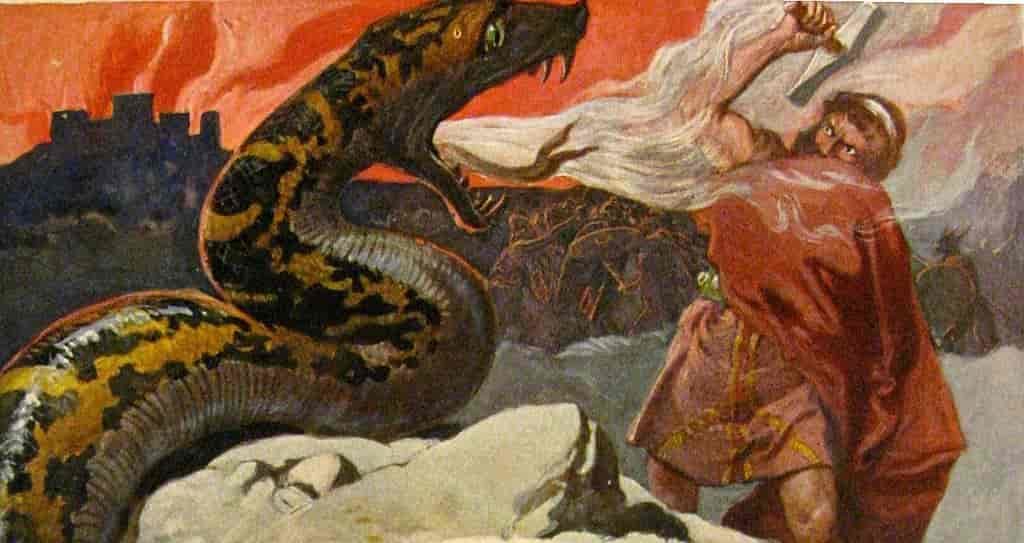
Many of the stories passed down in Norse mythology are about Thor. Often the tales of Thor have a comic touch, humour in the myths is something unusual and almost unique to the Nordic countries.
In research there is disagreement about how old the comic elements have been. In the past, there has been a tendency to explain them as the result of a late development, where the stories, from having had a much more serious character in pre-Christian times, have been changed for the sake of a Christian audience.
In recent years, however, a new view has gained ground, comedy is an original element in mythological tales, which may be due to the fact that the Norse did not perceive their gods as omnipotent and infallible beings, they were instead mortal, had less fortunate character traits and could make mistakes.
No one in Norse mythology was either good or evil, they were characterised as either enemies or friends.
Yet despite the often unfortunate circumstances, Thor always ends up victorious. His battles with the gods' enemies were continuous, and many stories of giant battles have been lost; a 10th-century poem, for example, lists numerous names of giants who had been slain by Thor. Below is a selection of the best known:
Thor's fishing trip
Once Thor asked the giant Hymer to take him fishing. He had disguised himself as a giant boy, and Hymer therefore refused to take him at first, but in the end Hymer gave in, on the condition that the boy himself provided his own bait, Thor then tore the head off Hymer's biggest ox.
Thor was set to row, but Hymer began to get uneasy as the boy rowed further out than any of his normal fishing spots. Out in the open sea, Thor stopped and threw the ox's head. He used an anchor as a hook, and it wasn't long before something bit.
When the boy was unable to haul up the catch, Hymer became seriously frightened. Thor stood up in the boat, tightened the strength belt and stamped his legs through the boat straight to the seabed.
As the thunder gathered in the sky, the Midgard Serpent showed its spider-evaporating maw, and Thor roared in triumph, raising Mjolnir to battle.
Then Hymer had enough and cut the fishing line; Thor then killed Hymer in a rage, and waded ashore. That same night, Midgard was struck by a terrible storm.
In some versions of the myth, Thor managed to hit the Midgard Serpent with his hammer, perhaps a relic of an older version in which he managed to kill the monster. Stories of sky gods slaying cosmic monsters are widespread in mythologies around the world.
However, Gro Steinsland does not believe that Thor necessarily killed the Midgard Serpent in earlier versions; it was an ambiguous creature, at once dangerous and hostile, but at the same time necessary for the stability of the world, as long as it lay coiled around the whole Earth, the cosmos existed.

When Hymer cut the cord, he thereby prevented the world order from being broken, which Thor in his hubris had in fact put at risk. The story is comic and burlesque in form, bringing together the cosmic and the everyday, with the god's battle with the monster taking place in a perfectly everyday situation familiar to the audience of the time, namely a fishing trip.
This comic setting for an extremely serious tale is a reflection of the Norwegians' in reality somewhat ambivalent relationship with the gods; here no one was entirely good or evil, and even the guardian of the cosmos could appear as a threat to world order.
The myth therefore functioned as a view and insight into the structure of the world and the nature of the god; he was an immensely powerful guardian, but not particularly wise.
When Thor, enraged and humiliated by his defeat, is forced to wade ashore, the very macho ideal of the Viking Age is made a mockery of, and the message of the story is that the chaos powers are also necessary for the world's survival.
This tale was undoubtedly very popular, as it appears in relatively many sources. The story is reproduced in Ragnarsdrápa, Hýmirskvídja and Gylfaginning, and is depicted on picture stones from Gosforth in England, Hørdum in Denmark and Altuna in Sweden.
Roskva and Tjalfe become Thor's servants
One night, when Thor and Loki were out, it got so late that the two had to take shelter in a farm in Midgard. There lived a farmer and his wife, together with their daughter Roskva and their son Tjalfe.
They gave shelter to the two gods, and Thor slaughtered both his goats to eat with his family. Thor instructed everyone to throw all the bones unharmed onto the goat skins after the meal.
But Tjalfe did not do as Thor had said, and broke a femur to eat the marrow. The next morning Thor noticed that one of the bucks was lame, and thus discovered that the peasant family was not doing as he told them to.
Thor was furious, so the farmer offered him everything he owned. Thor agrees to take his children Roskva and Tjalfe with him, and since that day they have followed him.
Thor and Utgard-Loki
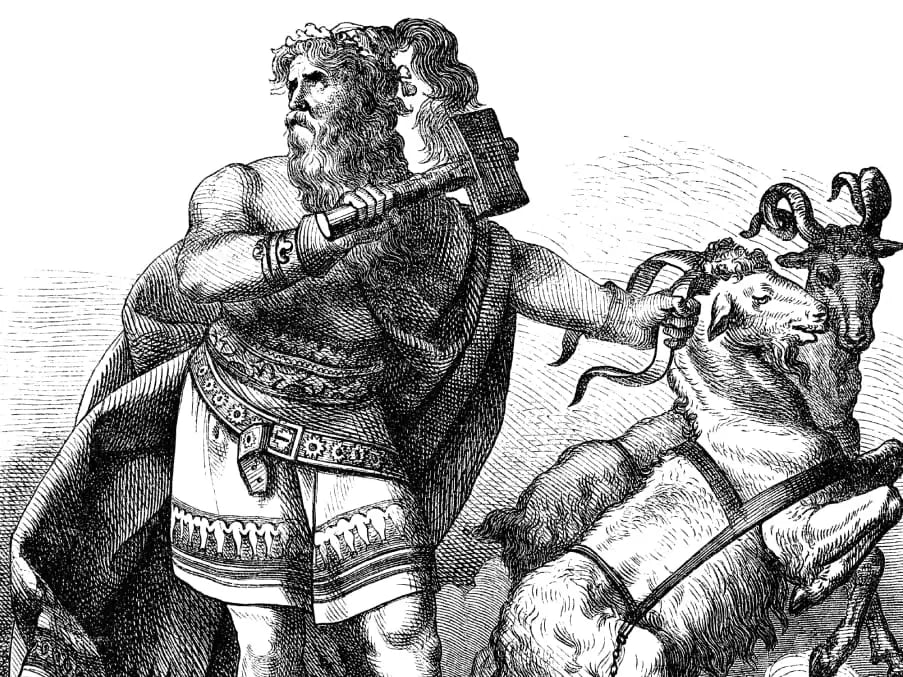
After Thor had taken Roskva and Tjalfe from the farmer, he left the goats behind and travelled on towards Jotunheim. Tjalfe was well on his feet, and carried Thor's provisions.
One evening they found an inn with five large rooms, and they lay down to sleep in one of them. In the middle of the night they were awakened by an earthquake that shook the whole house.
They then retreated to the smallest room, while Thor stood guard at the entrance, along with Mjolnir. When they awoke the next morning, they saw a giant lying beside the shelter, and the shelter was his glove. He was that big. The giant's name was Skrymer.
They agreed to go on together. Skrymer tied his own food together with theirs, and carried it all on his back. Then the next night came, and Skrymer went to sleep while the others would have supper. But not even Thor could untie the knots.
Finally, he was so enraged that he hit Skrymer on the head with Mjolnir as hard as he could. The giant woke up, and asked if a leaf had fallen into his head.
Later that night Thor was awakened by the giant's snoring, and he struck him again on the head. The giant woke again, and asked if an acorn had fallen into his head.
Thor was now even more frustrated by this, and could hardly wait until the giant fell asleep again, then he would kill him. When the giant was asleep again, Thor hit his temple with everything he had. Skrymer woke up again, and asked him if twigs had fallen on him.
Now morning had come, and their ways parted; the giant was going on up into the mountains, while Thor and his retinue were going to Udgard. They were glad to be rid of the giant.
Finally they arrived at the castle of Udgardslok. There were many giants sitting in the hall. When they entered, the giant Utgard-Loki said that here everyone must know an art that no one else knew as well.
He asked Thor and his retinue what they could do. Loki replied that no one could eat as fast as him. So Utgard-Loki asked Loki to come out onto the floor and eat with Loki.
They raced in the same trough, and met in the middle, but since Loki had only eaten the meat, while Utgard-Loki had eaten the bones and trough too, Loki lost.
Outgoing Loki then asked what Tjalfe could do, and was told that Tjalfe would like to race one of them. He got Huggr to race with.
In the first race, Huggr finished so long before Tjalfe that he could turn to face Tjalfe before he finished. The next race went the same way.
But the third time, Tjalfe hadn't even reached the halfway point by the time Huggr had finished. Then Utgard-Loki asked Thor what he could do.
Thor wanted to drink in the race. Then Utgard-Loki asked his cupbearer to find the great drinking horn, from which the hirdmen were condemned to drink if they had trespassed.
He told Thor that he should be able to empty the whole horn in one gulp, and that few were allowed two sips, and hardly anyone three. But even after three sips, it was almost impossible to tell that the horn had been drunk.
Then Utgard-Loki challenged Thor to a game - Thor had to try to lift his cat off the floor. The little boys of Utgard used to have fun with that, so Thor should be able to do it.
But no matter how high Thor stretched to lift the cat, it only lifted one foot. Thor was furious, and then challenged someone to come to him and let them see how strong he was.
Utgard-Loki called out to his old great grandmother Elle, who came in and grabbed Thor, no matter how hard Thor pulled on her, Elle just stood firm. It didn't get any better than Elle bringing Thor to his knees.
They stayed overnight, enjoying all kinds of hospitality. The next morning, when Thor and his companions were about to return home, Utgard-Loki asked Thor what he thought of his stay with him.
Thor replied that he had had no honour in it, and was grieved at how they should look upon him as a weakling. Utgard-Loki then admitted to Thor that since Thor was as strong as he was, he would never be allowed to enter the castle again, for he would only bring them disaster.
He then told Thor that he and his retinue had been tricked by a trick of the eye, for it was Utgard-Loki himself who was the giant Skrymer, and he had kept a whole mountain between himself and Thor's hammer, or Thor would have killed him in the first battle.
And the contests - Logi was the fire that could consume both flesh and trough. Huggr was Utgard-Loki thought. And at the other end of the drinking horn from which Thor drank was the sea, and it was the very sea of the world that had sunk when Thor drank.
When Thor lifted the cat, they were all terrified, for it was not a cat but the Midgard Serpent that Thor had fought. He had lifted it so high that only its head and tail had touched the ground. And in the end, the old she-wolf that Thor had dealt with was old age itself.
Never has there been, and never will there be, anyone who will not eventually fall to old age.
So Utgard-Loki had hoped that Thor would never pass his castle again, for then he would have to devise similar tricks. Thor raised the hammer and wanted to strike Utgard-Loki, but suddenly he was gone, so was the castle, and Thor had to turn around and go back to Trudvang.
Thor and the ferryman
Thor had been away fighting giants, as he so often was. On the way home he was going to cross a sound, but the ferryman standing on the other side would not take Thor across.
He mocked Thor for being barefoot and shabby after his long journey, and reminded him of the time he had timidly hidden himself in Skrymer's glove. Thor was told that the ferryman was called Harbard, but did not know that it was really Odin who had disguised himself.
No matter what Thor said to him, all he got back was mockery. When Thor asked Harbard where he had learned to talk like that, he was told that he had learned it from the old men who live in the burial mounds.
He also said that Thor should hurry home to Sif, for she had a lover visiting. Thor finally gave up and went away, but promised to take revenge the next time they met.
Trym steals Thor's hammer
The story began with Thor losing Mjolnir while he slept, it was his main weapon and protection against the gods' enemies, and thus the Aesir's best protection.
Loki found out that it was the giant Trym who had stolen it, and he refused to return it until he was married to the most beautiful of all the goddesses, Freya.
She refused too, and Thor ended up dressing up as Freya, using two stones as breasts. Loki had to go with Thor and dressed as a bridesmaid.
When they arrived at Trymheim, Trym noticed that the bride was eating unusually much for a lady, but Loki then explained that she hadn't eaten anything for the last 8 days because she was anxiously waiting to get married.
Then Trym asked why she had such evil eyes, and Loki then had to explain that she hadn't slept for 8 days either, because she was looking forward to the wedding so much.
Finally, Trym's sister hands the hammer to the couple, whereupon Thor crushes all the giants with it, and Thor and Loki can go home again. In its familiar form, the story is a comedy in which the normal social patterns are turned upside down, it is now the giant Thrym who owns Mjolnir, and to win it back Thor must dress up as a female and almost marry a giant, a lower-ranking social being in Norse cosmology.
The deprivation of Mjolnir functioned as a deprivation of Thor's manhood and thus his power to act. The story ends, however, with the restoration of normal world order.
Thor saves Loki from the giant Geirrod
The giant Geirrod had once captured Loki, and he then forced Loki to lure Thor there without his hammer and belt of strength. Geirrod believed that Thor could easily be killed without his weapons.
On the way there, Loki and Thor spend the night at the home of Grid, a giantess, and she gives them a pair of iron gloves, another belt of strength, and a mysterious staff called Gridarvol.
When Thor arrives at Geirrod's farm, he first kills Geirrod's two daughters by breaking their backs. Geirrod is furious, and throws a glowing iron rod at Thor.
Thor grabs the rod with his iron gloves and throws it through an iron pillar, through Geirrod himself, and into the ground outside. Thus Geirrod died.
Thor's fight with Hrungner and Mokkurkalve

Thor was out hunting giants while Odin was riding Sleipnir to Jotunheim. Odin then came to the farm of the giant Hrungner. Hrungner wondered who Odin was, and commented on both his helmet and the fine horse.
Odin replied that faster horse did not exist. But Hrungner had a horse called Goldfax, which he thought must be faster. So they made a bet.
Odin rode much faster than Hrungner, and Hrunger was so furious that he completely forgot where he was riding to, and ended up in Asgard. There he was invited in for a drink, and was offered one of Thor's bowls, which he emptied in turn.
Hrungner got drunk, and began to boast, he could probably lift up the whole of Valhalla, and move it to Jotunheim. He might also sink all Asgard, and slay all its inhabitants, except Freya and Sif, whom he would take with him, for they were so beautiful.
The Aesirs were afraid of him, and began to talk about Thor, just then Thor came in with his hammer raised. He was furious because Hrungner was sitting there, and he was not an Aesir, but a giant. They argued a bit, and Hrungner challenged Thor to a holmgang at Grjotunagard.
When the gods got there, Hrungner had a man made of clay, nine miles high, his name was Mokkurkalve, and he stood beside Hrungner. The battle began, but Thor could not pierce Hrungner's stone shield with the hammer.
Tjalfe then sounded Hrungner and told him that Thor was planning to come up through the ground beneath him. Hrungner therefore put his shield under him, whereupon Thor threw Mjolnir at him, hitting Hrungner's head so that it shattered. At the same moment Hrungner threw his grindstone at Thor, but Mjolnir smashed it in two pieces in the air.
One piece hit Thor in the forehead and stuck. Tjalfe got a hold of Mokkurkalve, but when he fell his foot came to rest over Thor's neck, so that he could not get up. Thor's son came and moved the foot, even though he was only three days old.
Magne was then given the horse Goldfax as a thank you. Groa the wolven began to sing gallows to get the stone out of Thor's forehead, but when Thor told how he had once saved her husband, Aurvandil, she was so happy that she forgot the gallows. The stone therefore remained.
The joust between Thor and Hrungner may be a relic of a ritual associated with Thor, it may have been related to the lighting of sacred fire or a rite of passage for boys who had become grown men.
Alvismal
In Thor's absence, the other gods promise his own daughter Trude away to the dwarf Alvis. For a god, this was a most inappropriate relationship, and it was a most humiliating situation for a father when he could not decide for himself whom his daughter should marry.
Thor, however, tries to avoid the marriage, and overcomes Alvis with something as unusual for him as cunning. Thor looks after the dwarf, forcing him to answer questions until the sun rises and Alvis is turned to stone.
Thor was thus challenged in his ability to protect the women of his lineage, and his position as man and head of the family was thereby put at risk.
The dwarf Alvis' name probably plays on both his cleverness, because he can answer all Thor's questions, and his stupidity, because he does not detect Thor's cunning.
Thor's death
The prediction of Thor's death is retold in both the Old and Younger Edda, here it is said that Thor will meet the Midgard Serpent at Ragnarok, and there they will kill each other.
First Thor will kill the worm, but he will only walk nine steps before he himself passes out and dies from all the poison the worm has spewed out on him.
While the account of their first meeting during the fishing trip, which ended in the status quo, was full of humour, their second meeting is presented with great seriousness, here the outcome will be quite different.
Cult of Thor
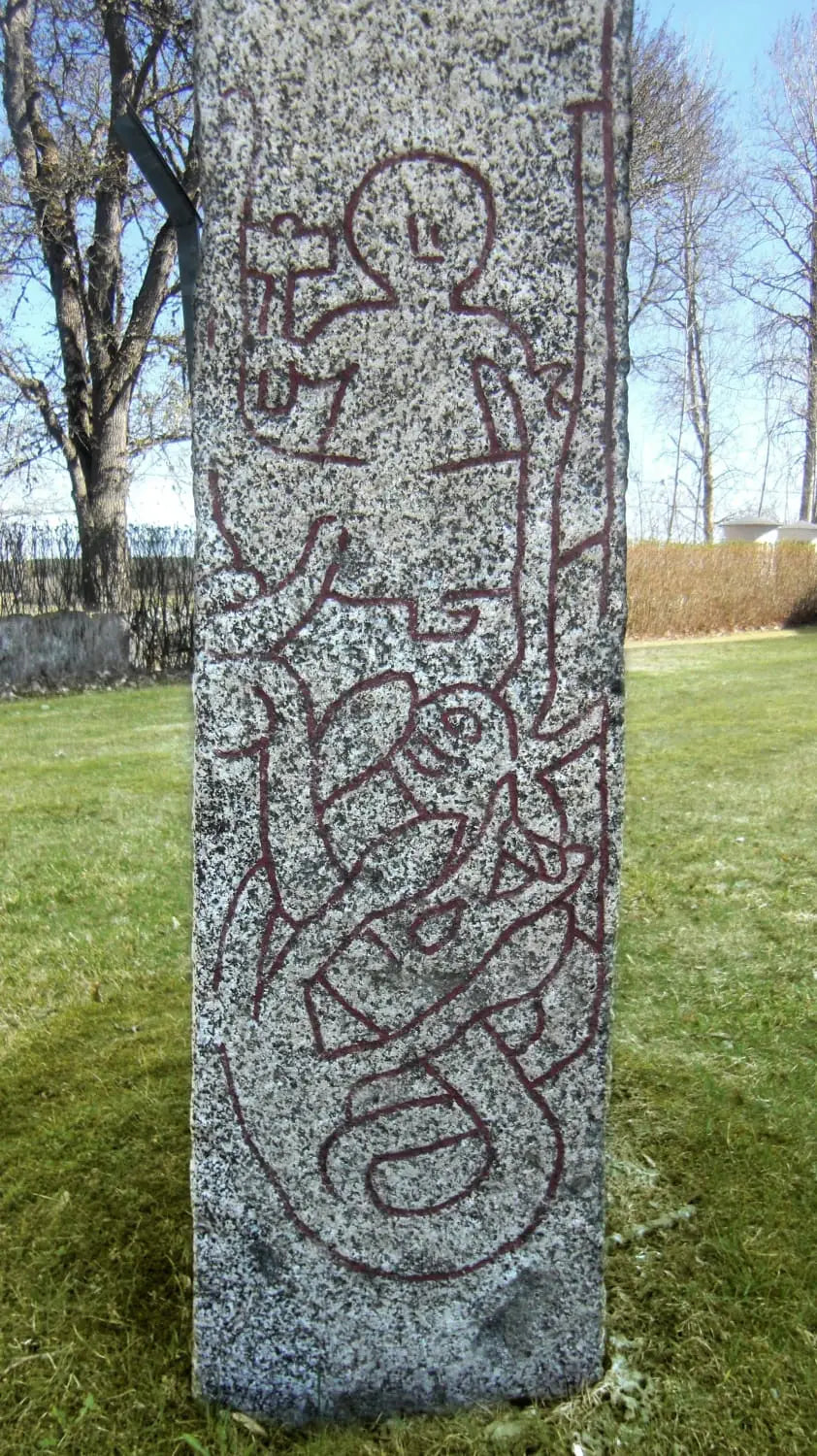
The preserved source material for the rituals of Thor's cult is, as for the other gods, much weaker than for the mythology. The descriptions of the cult are therefore marked by great uncertainty.
Statues and images depicting Thor appear in the sources more often than any of the other gods. And when he was displayed together with other deities, Thor was always placed in the most prominent position.
This type of figure is described several times as man-sized, but those that have been found are all smaller than that. The statues were used in rituals such as bloodletting and divination. In Norway, food offerings such as brew and meat were offered to him.
In some rituals, a god figure was placed on a cart and pulled around. In most cases, vanguards were involved in this custom, but in a few cases it is also associated with Thor; who also had a chariot as one of his main features.
Dudo of St. Quentin wrote around the year 1000 that the Normans in earlier times had sacrificed humans to Thor. Norse sources mention several cases of people having their backs broken on a stone, which may have been a sacrificial practice of the Thor cult.
In Eyrbyggja Saga there is a description of a temple dedicated to Thor. It was built by the countryman Thorolf when he settled in Iceland. It mentions a number of the objects found in it.
Inside were two high pillars, on which were two 'reginnagles', a cauldron for collecting the blood of sacrificial animals, a gold ring, and images of both Thor himself and other gods.
The gold ring was used when swearing an oath, indicating his position as a god of justice. The regin nails were probably carved images of the gods, with an iron nail or a piece of flint inserted for use as a firebrand.
This description of a temple is primarily a valuable source for 13th century views on the decoration of pagan shrines may have been partly inspired by Christian conditions, but much in it is supported by other sources.
The hammer symbol was widespread and used in both private and public worship. In the Viking Age it was used in the same way as the Christian crucifix and was a symbol of life, used both for protection and blessing. At weddings, a hammer was placed in the bride's lap. It was used when a newborn child was introduced into the family and at funerals.
According to Icelandic traditions, Thor worshippers lived on with their relatives after death, not in the burial mound where they were laid, but in a special mountain, for example. Thor's attachment to the family and to ancestor worship shows that he was attached to society in general.
Thor had probably taken over Tyr's role as god of justice, as he is often associated with oath-taking and the Thing Assembly for example, the Icelandic Alting always opened on a Thursday, and Adam of Bremen mentions a large statue of Thor erected in connection with the Thing in Uppsala.
